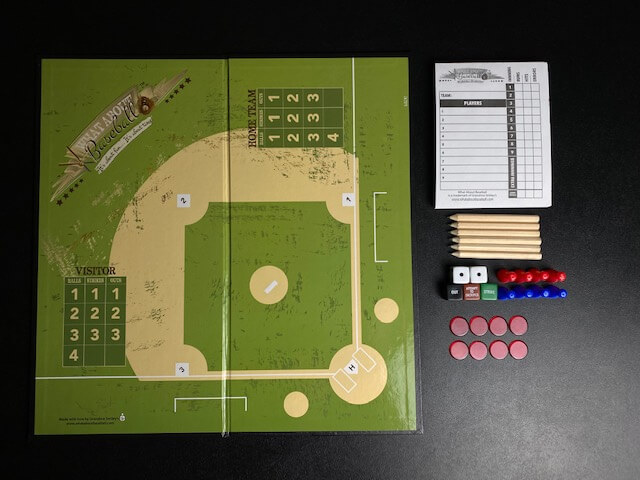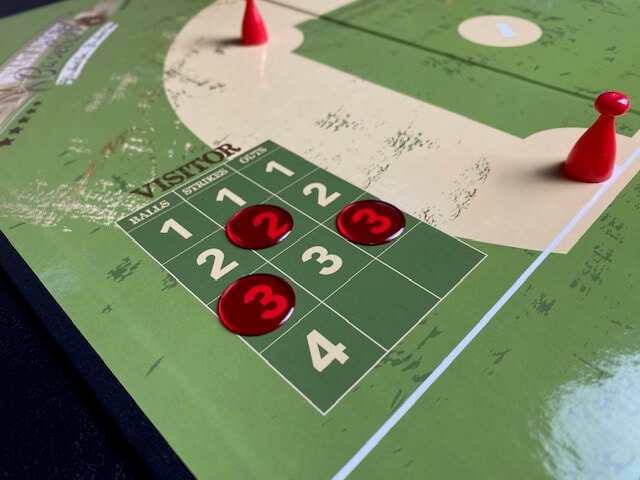
OBJECTIVE: Be the player with the most runs at the end of the 9th (or final) inning.
NUMBER OF PLAYERS: 2 players, or two teams of multiple players
TYPE OF GAME: Dice game, Board game
AUDIENCE: Kids and Family
INTRODUCTION
There is a long history of baseball dice games in the United States, and What About Baseball is a fine addition to that tradition as a dice baseball game. Thematic proprietary dice are used alongside classic six sided dice to help determine outcomes of play. Following basic or advanced rules, players will pitch, hit, and move pawns around the ball diamond with the hope of scoring the most runs. This is one tabletop baseball game, but there are other baseball games to explore as baseball fans! If you have played dice baseball games before you know that while not the same game, there are lots of similarities. Here is another game that is similar to this one.
WHAT’S IN THE BOX
The box comes packed with a baseball diamond game board, four pawns for each team, eight red chips for tracking strikes, balls & outs, two white six sided dice, a green pitching die, a brown batter’s die, and a black defensive die. You also receive a pad of score sheets and six pencils.

SETUP
Set up the game by choosing who will be the home team and who will be the visiting team. The visiting team bats first. The batting team chooses to use the blue or red pawns, and the home team takes the opposite color. Pawns are used as base runners. Each player is also given three red chips which will be used for tracking balls, strikes, and outs.

THE PLAY
There are two modes of play: basic and advanced.
BASIC PLAY
This mode uses the two white six sided dice, the green pitching die, and the red chips. Each at-bat begins with the pitcher rolling the green die. There are four possible outcomes from the pitch dice roll: ball, strike, foul ball, and contact.
If ball is rolled four times, the batter is walked. The batting player places a pawn on first and advances any other runners appropriately (just as in real baseball). If three strikes are rolled, that batter is out. If foul ball is rolled, it can count as the first or second strike. A player cannot strike out on a foul ball. If contact is rolled, the batting player has the chance to hit the ball. This is done by rolling the two white dice.
The batter rolls the white dice to determine what type of hit they make. After rolling, the total of the two dice determines the hit. Any roll that totals less than 9 is an automatic out. A total of 9 is a single. The batter advances to first, and any other runners on base advance one base. A total of 10 is a double. The batter advances to second base, and any other runners advance two bases. A total of 11 is a home run. The batter and all other base runners score. A 12 is a triple. The batter advances to third, and all other base runners score.
Any time a runner crosses home plate, that team scores a run. Be sure to document runs at the end of each half-inning.
During play, the batting team must keep track of balls, strikes, and outs by using the red chips.
Once three outs are recorded, players switch dice. The opposite team now bats. Once that team records three outs, the inning is over. The game is played over the course of nine innings.

ADVANCED PLAY
The advanced mode of play incorporates the brown batter’s die and the black defensive die.
For this mode, when the batter rolls a double that equals 8 or less (double 1’s, 2’s, 3’s, or 4’s), they are NOT automatically out. They get to roll the brown die for a second chance at the bat. If the bases are empty (no runners), there are three possible outcomes. When reach on error is rolled, the batter may go to first base due to a defensive error. If wild pitch is rolled, the batter stays, and the pitch counts as a ball. Any other side of the die has no application. The batter is still out.
If there are runners on base, the brown die has six potential outcomes. When reach on error is rolled, the batter advances to first base, and all other runners advance one base. If attempt to steal is rolled, the lead runner attempts to advance one base. The pitcher rolls the black die which determines whether the runner is safe or out.
The at-bat continues after the attempt unless the runner gets out and ends the inning. If attempt to sacrifice fly is rolled, all runners advance one base and the batter is out. If this does not cause the third out, the pitcher rolls the black die to try and get the lead runner out. When balk is rolled, the at-bat continues after all runners have advanced one base. If wild pitch is rolled, all runners advance, and the pitcher rolls the black die to try and get the lead runner out. Unless the third out occurs, the at-bat continues, and the wild pitch counts as a ball. If double play is rolled, the lead runner and the batter are thrown out.
ADDITIONAL RUN SCORING RULE
Sending the lead runner an additional base is an optional rule that can be incorporated. For example, if there is a runner on first, and the batter hits a single, that first base runner advances to second. The batting player may choose to send that runner to third. If they choose to do so, the pitcher rolls the black die for an out attempt.
WINNING
The player with the most runs at the end of the 9th inning is the winner. If the game is tied at the completion of the 9th, additional innings are played until there is a winner.
- TRIPLE SNAKES - February 15, 2021